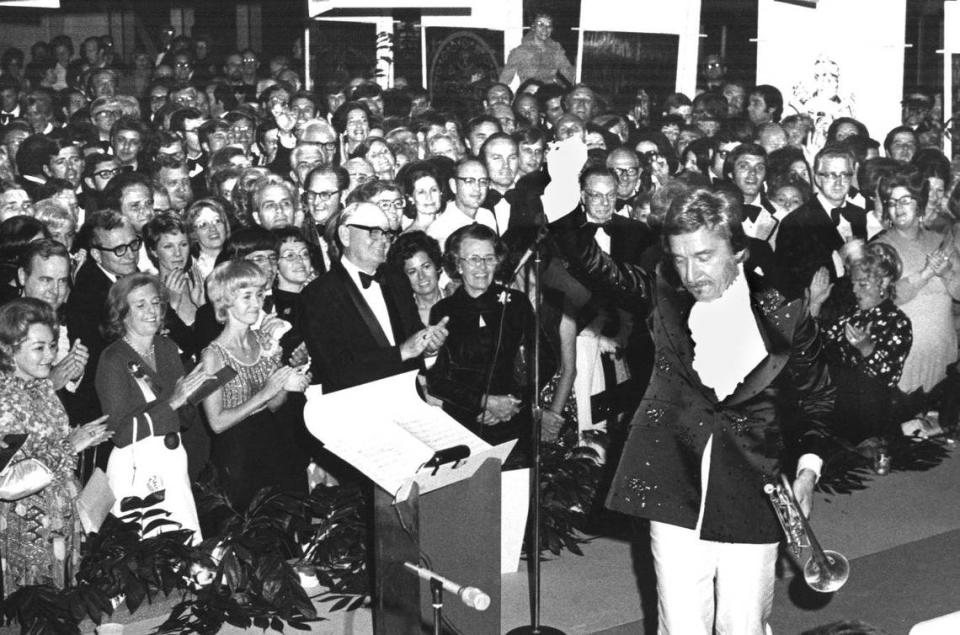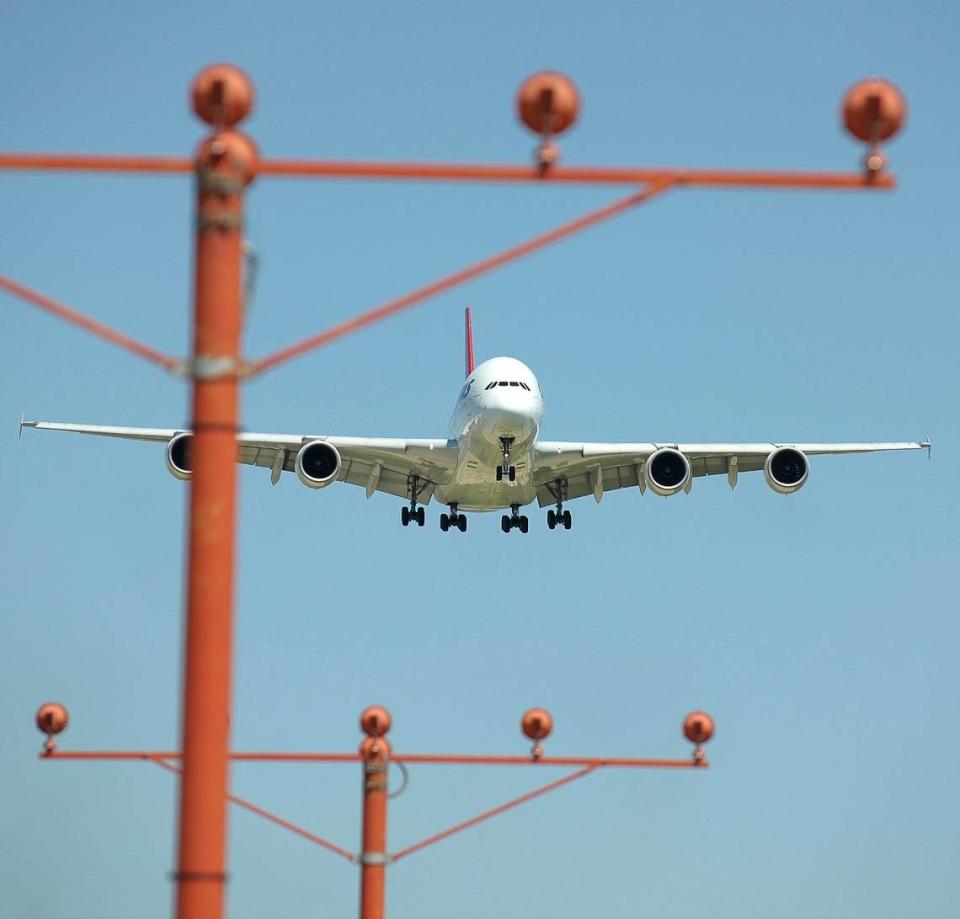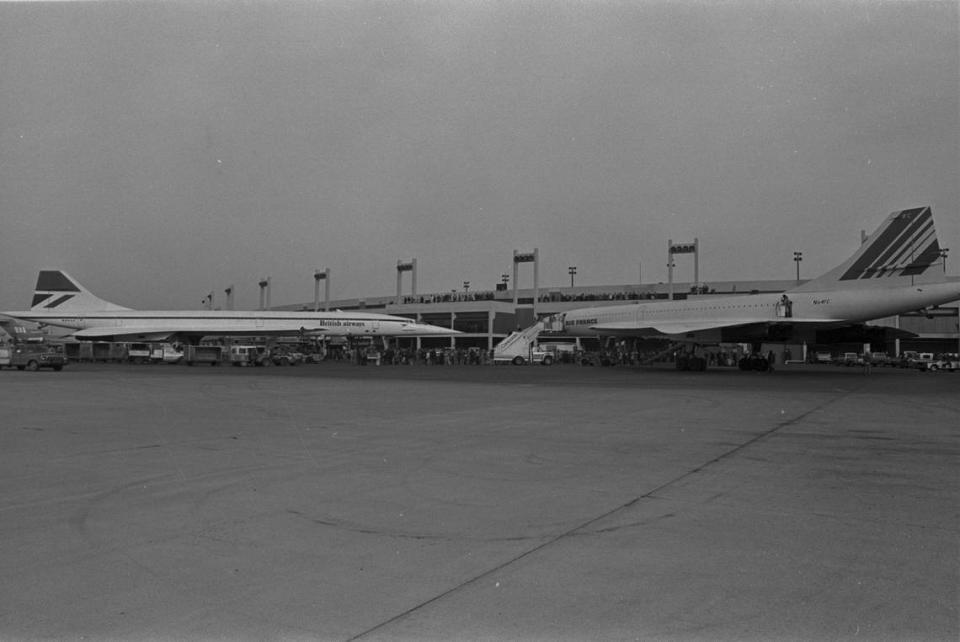50 years later: How DFW Airport became an engine of growth for booming Dallas-Fort Worth
It was 1973, and Grapevine Mayor William Tate was 31 and the Metroplex was home to the new Dallas/Fort Worth Airport.
Tate boarded a plane with other officials from Tarrant County and took flight. The aircraft made several loops before landing at the newly minted airport. It was a ceremonious affair, with speeches and parties for a week. Doc Severinsen, the jazz trumpeter from “The Tonight Show,” made an appearance one night, Tate recalls.
“I have a very vivid memory of that day,” he says with a chuckle, decades later, recalling the September designation of what was then called the Dallas-Fort Worth Regional Airport.
Fifty years later, Tate still leads the city, in a region transformed by the airport. The airport is jointly owned by Dallas and Fort Worth, but falls in Irving, Euless, Grapevine and Coppell.
Saturday marks five decades since DFW Airport opened on Jan. 13, 1974, linking two of the state’s largest cities and connecting them with the world.

What started as four terminals, three runways and 66 gates — the biggest airport in the world at the time — is now a hub for more than 73 million passengers with five terminals, 168 gates, and plans for expansion. It was the second busiest airport in the world in 2022.
What was a Metroplex of 2.6 million people 50 years ago is now the fourth-largest metro area in the nation, attracting visitors and residents alike.
“Thinking regionally has made us a global entity,” said Steve Montgomery, president and CEO of the Fort Worth Chamber of Commerce.
There’s been turbulence over the years, but decades later North Texas leaders call the airport a success and are looking ahead.
“It’s been a great 50 years, and it’s going to be an even better next 50 years, we think,” said Sean Donohue, DFW Airport’s chief executive officer.

The airport’s beginnings
The landing of American Airlines Flight 341 marked the official opening of the airport. It flew from New York, and stopped in Memphis and Little Rock before it landed right on time at DFW, according to the Texas State Historical Association.
The aircraft’s landing was smooth, but getting there was a long and bumpy process.
A joint Dallas-Fort Worth airport was first proposed in 1927, but negotiations fell through, the first of several attempts between the two cities that have historically had a contentious relationship. (A famous example: Star-Telegram publisher Amon Carter was known for taking a sack lunch with him to Dallas to avoid spending money in the neighboring city.)
It wasn’t until the 1960s that serious talks began for the airport.
In the late ‘50s and early ‘60s, traffic at Greater Southwest International Airport in Fort Worth was dwindling and Love Field in Dallas was congested.
In May 1961, the then- Federal Aviation Administration head Najeeb Halaby told reporters that Dallas and Fort Worth needed to create a joint airport.

By 1965, a board with seven members from Dallas and four from Fort Worth was in place to develop what would become Dallas/Fort Worth Airport. Construction began in December 1968.
“Early Disputes Open Door to Future” declared a Star-Telegram headline in September 1973.
Former Fort Worth Mayor Kenneth Barr wasn’t in the office at the time of negotiations — he wouldn’t take office for decades — but his father, Willard Barr was, serving as mayor from April 1965 to April 1967.
“I can’t think of any stories that I can share with you,” Barr said, with a laugh, asked what he remembers about his father during the negotiations. The airport was often a topic at the dinner table, he recalled in an interview with the Star-Telegram. “I remember there was a lot of frustration.”
But what would follow is an airport that Barr describes as “the greatest success story between two cities, the greatest partnership between two cities, that I think has ever existed anywhere.”
Challenges and a changing Dallas-Fort Worth
That’s not to say challenges wouldn’t continue over the years.
There were disputes between DFW and Southwest Airlines and Love Field over the Wright Amendment of 1979, designed to protect DFW Airport from competition. It restricted Love Field flights, where Southwest operates, to Texas and its neighboring states. The policy was lifted in 2014.
Tragedy would ensue in 1985 when Delta Airlines Flight 191 crashed at the airport and 137 people were killed, and again in 2001, when the world was shaken by the Sept. 11 terror attacks. The events changed airline travel across the country.
“There was great concern about security at the airports, and I don’t remember the specifics of exactly what we did, but immediately we had to tighten up everything related to airport operations,” said Barr, who was mayor at the time. Later adding that, “DFW handled all that better than virtually any airport in the country.”
The world, including airline travel, would again be shaken by the COVID-19 pandemic, as travel restrictions took effect and people shuttered in at home.
As the challenges unfolded, it was against the backdrop of a growing North Texas. The airport has played a role in much of that growth, community leaders say
Dallas-Fort Worth’s population has passed 8 million people, with Fort Worth gaining more new residents than any other city in the United States between 2021 and 2022.
North Texas is home to major aviation companies Southwest Airlines, American Airlines, Lockheed Martin and Bell, as well as other large companies AT&T, DR Horton, Texas Instruments and McKesson.
DFW Airport brings in $28 billion in visitor spending, $5 billion in state and local tax revenue, and about 60,000 people work at the airport.
Many people have come here, largely, because of the ease of access and companies’ ability to easily move to the area, said Mike Rosa, the senior vice president of economic development at the Dallas Regional Chamber.
“All of that rooted in the decision years and years ago to come together and create what at the time was hoped to be exactly what it has turned out to be,” Rosa said. “It’s just a wonderful, wonderful asset.”
Montgomery, the president and CEO of the Fort Worth Chamber of Commerce, measures the airport’s impact on the region by looking at the direct and indirect jobs it has created and the access it provides to business and commerce.
“Its access to the globe is what it’s given us, and not only our access to the globe, but the globe’s access to us,” said Montgomery.
Fort Worth Mayor Mattie Parker, who sits on DFW’s board of directors, said the airport has been “pivotal” to growth in the region and for Fort Worth in particular.
“I do not think Fort Worth would be where it is today without DFW airport, and it took a tremendous amount of vision to make sure that was possible,” Parker said.
For Tate, the Grapevine mayor who was first elected in 1973 and has served ever since, with the exception of one term in the late ‘80s, there have been disappointments. Grapevine has been left out, he said.
There’s no question the airport has benefited Grapevine a great deal, he said. A lot of people are in the city because of the project, he said. Grapevine is home to more than 51,000 people compared to 7,000 in 1970. But he would like the region to realize that Grapevine has taken on negatives that Dallas and Fort Worth were able to pass on to its neighbors.
There are environmental concerns and noise that comes with an airport, he said. Grapevine has also been limited in its ability to collect tax revenue off of the airport, he said.
“Airports, I can say, they’re a blessing and they’re a curse wherever they are, whether they’re in your own city or they’re in somebody else’s,” Tate said. “That’s the history of it, and it takes the cooperation of everybody to reduce that impact.”
The future of DFW Airport
The airport plans to spend $9 billion on improvements and the new Terminal F by 2029, when it expects to see 100 million passengers each year.
DFW is already thinking decades ahead, with plans in the 2030s to incorporate more autonomous vehicles and AI features, and goals of fully automating the passenger experience from home to gate by 2040.
“It is just critical that we are planning and designing and forecasting growth correctly, because if we did not enable the growth of the airport, then we become an economic constraint on the region, and we can never, never allow that to happen,” said Sean Donohue, the chief executive officer of DFW airport.
The airport larger than most others in the country, spanning more than 26.9 square miles. Fort Worth and Dallas leaders’ decision decades ago to put the airport on the acres of open farm land was “visionary,” Donohue said.
“It just continues to allow us to grow,” he said, noting that there’s room for an eighth runway.
So what’s in store for 50 years from now?
Donohue believes DFW will be the busiest airport in the world. A lot of that is driven by the growth in the region, he said.
He also wants to continue being an “economic engine” for Dallas-Fort Worth and provide the best customer experience in the world.
Parker pointed out that a lot has changed about air travel over the past five decades, and air travel could look totally different in another five.
“There may be airports that struggle with what the future of aviation looks like,” she said. “I do not think that DFW Airport will be one of them.”

